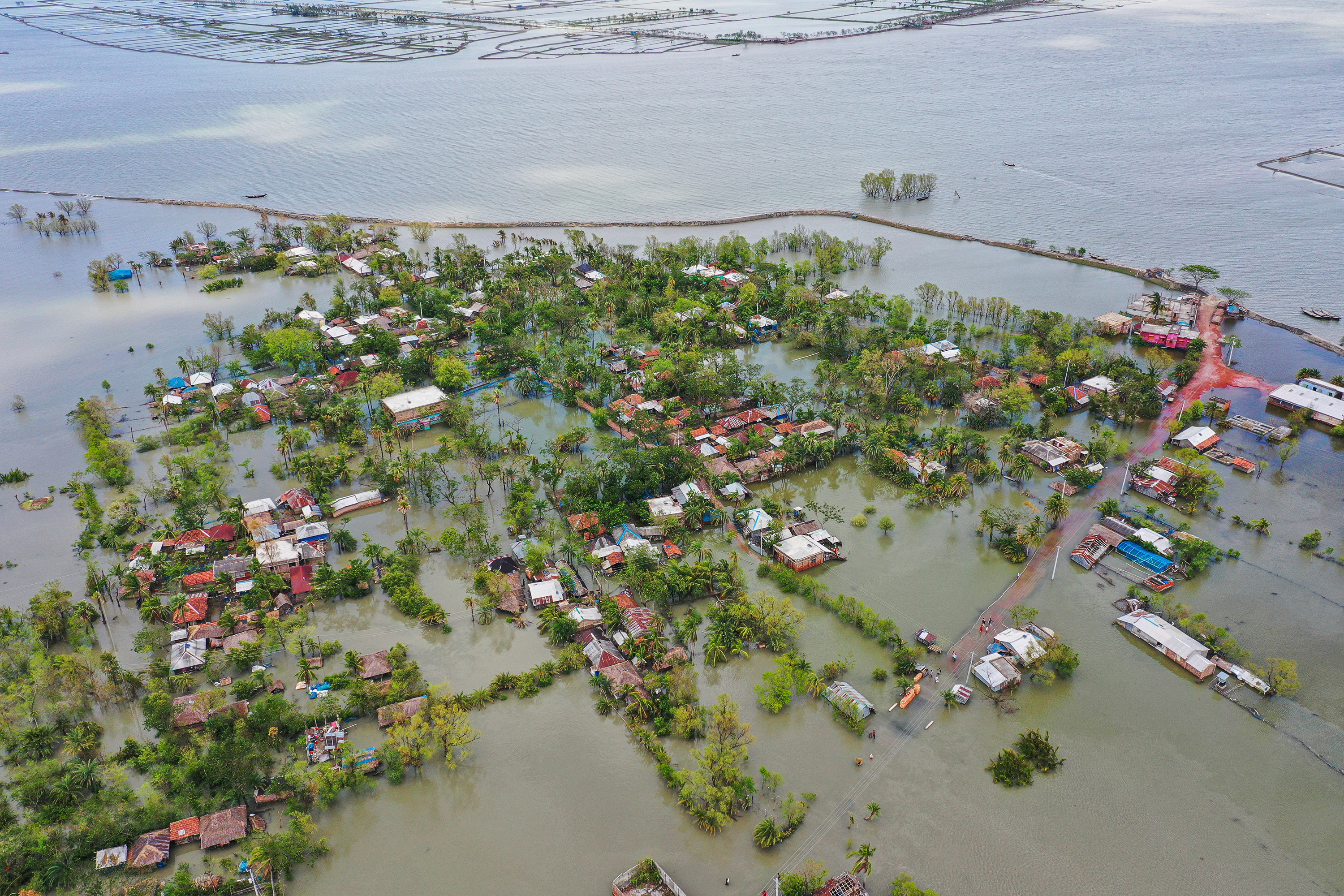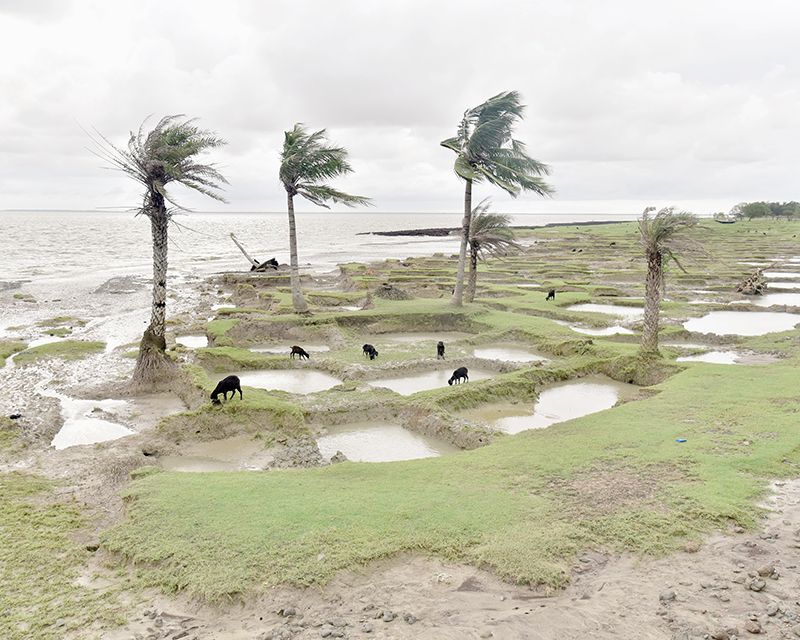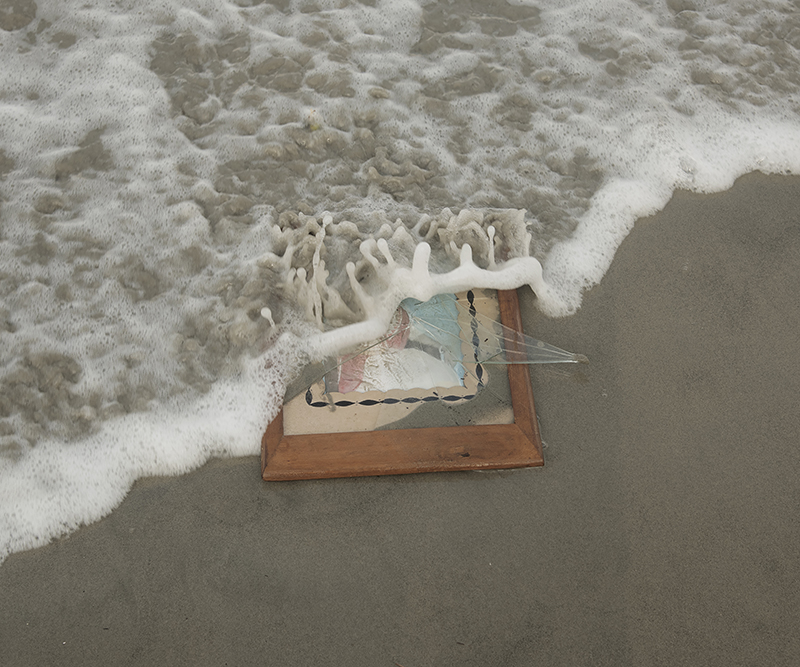Asia’s biggest climate migration
On May 20, Super Cyclone Amphan was expected to make landfall in the Indian state of West Bengal. That morning, as the wind picked up, Mitali Mondol and her husband, Animesh, fled their house, leaving behind everything they owned.
The Mondols live in Gosaba, an island in the Sundarbans, an archipelago that is home to the world's largest mangrove forest. They knew of only one flood shelter. It was far away. As they reached higher ground, they ducked into a restaurant. The restaurant quickly filled up-with family and friends, some of whom brought their goats and hens. Standing as close to the windows as they dared, the villagers watched as the waves climbed to 15 feet high. Then the water broke the embankments. Trees fell, power lines collapsed, and roads vanished.
The region has witnessed 15 major cyclones in recent years, of which Amphan was the latest. Cyclone Sidr, which ripped through the islands in 2007, killed at least 3,000 people; only two years later, Cyclone Aila killed nearly 200. Cyclone Fani, in 2019, killed another 81 people, and caused over $8 billion in damage. It was the strongest pre-monsoon storm on record in the region, until it was surpassed by Amphan. According to Climate Nexus, an advocacy group, Back-to-back years of major cyclones in the Bay of Bengal, that rapidly intensify over unusually warm sea surface temperatures, are consistent with trends showing an increase in cyclone intensity in the region due to human-caused climate change."
 Flooded areas after the landfall of cyclone Amphan. Thousands of shrimp enclosures were washed away, while numerous thatched houses, trees, electricity and telephone poles, dykes and croplands were damaged, and many villages were submerged by the tidal surge.ZABED HASNAIN CHOWDHURY / SOPA /SIPA USA VIA AP IMAGES
Flooded areas after the landfall of cyclone Amphan. Thousands of shrimp enclosures were washed away, while numerous thatched houses, trees, electricity and telephone poles, dykes and croplands were damaged, and many villages were submerged by the tidal surge.ZABED HASNAIN CHOWDHURY / SOPA /SIPA USA VIA AP IMAGESWhen Amphan hit land, the winds were over 160 miles per hour. The storm surge reached four meters in places and was the principal cause of damage, according to a paper by researchers from the University of Bristol made available as a preprint by the Lancet in October. Under several realistic scenarios for sea-level rise, the researchers predict that-damaging as Amphan was-the impact of a similar future storm on the Indian side of the Sundarbans might be twice as bad.
The Sundarbans span 4,000 square miles (10,000 square kilometers) in India and Bangladesh and are home to around 7.5 million people. About a third of the 4.6 million people on the Indian side live in extreme poverty, which the World Bank defines as living on less than $1.90 per day. (In Bangladesh this figure is even higher.) Many have started to migrate from the Indian Sundarbans to mainland West Bengal. If the trend continues, it will constitute the largest movement of climate migrants in Asia and, indeed, one of the largest in the world.
Cyclone Amphan killed over a hundred people. Some died when trees fell on them, others were electrocuted by downed wires, and yet others were trapped inside buildings that collapsed.
Mitali Mondol and her husband survived unharmed. Their house was also miraculously untouched. But water had flooded their rice paddy, destroying the harvest. The salt in the water had rendered the land useless for the next three or four years. For a while the state government came through with supplies, bringing in rice and lentils by boat. But West Bengal had one of the highest rates of covid-19 in India-today, the death toll stands at more than 7,000. With the government fighting on multiple fronts, there were days when supplies ran out or didn't show up. The Mondols sometimes went to bed hungry.
With no land to cultivate, and no jobs available, Animesh has taken to fishing in the network of freshwater creeks that swirl through the delta's jungles. The fish are plentiful, but there are also venomous snakes, crocodiles, and even man-eating tigers. The situation has left the newly married couple deeply anxious for their future. If there's another cyclone like Amphan," Mitali Mondol says. We will die. All of us in the Sundarbans will die."
Triple whammyThe Indian islands, which are located off the coast of West Bengal, plunge into the Bay of Bengal like dozens of bright green fingers, taking their color from the sundari, as the dominant local species of mangrove is known. The trees thrive in the delta's slushy mud flats and are the first line of defense against storms. Because they have a dense network of roots that can survive both above and below the waterline, the mangroves reduce wave force and capture sediments. But they are under constant threat from illegal logging. They are also vulnerable to crown death, a disease that has already killed millions of mangroves.
The mangroves are mobile," says Susmita Dasgupta, an economist at the World Bank: they move back and forth to avoid getting overwhelmed by the water. But dense human settlements have reduced the amount of free space available to them.
The triple whammy-deforestation, crown death, and overpopulation-is proving too much for the trees. Because they're an essential component of the Sundarbans, any change to them automatically affects people with forest-based livelihoods-fishers, crab and honey collectors, and those who rely on the forest for fodder and fuel.
 Almost 70% of the surface area of the island of Ghoramara, pictured in 2016, has disappeared in recent years. The island may soon disappear entirely.SUSHAVAN NANDY
Almost 70% of the surface area of the island of Ghoramara, pictured in 2016, has disappeared in recent years. The island may soon disappear entirely.SUSHAVAN NANDYNow, the mangroves are facing one more threat: climate-related sea-level rise. The rising tides pour salt water into the mud flats, killing the trees. The salt water then moves from the mud flats towards the embankments, which it breaches during heavy storms. From there it enters arable land, gobbling roads, crops, animals, and houses.
Already, at least four islands have been fully submerged. More than 40,000 people have been forced to relocate from a fifth. In all, soil erosion will cause at least eight islands, seven of them in India, to simply vanish, displacing tens of thousands of people.
When the people of the vanished islands first moved, around 15 years ago, it was to Sagar, a bustling cluster of villages about 100 kilometers from Kolkata, the provincial capital. The state government set them up in refugee camps. At the time, it followed national government policy, which refuses to pay compensation for damage related to climate change. Although some people received financial assistance, others were forced to remain in the camps where, 15 years later, they still live.
These camps started to swell in size. Their continued presence is now stoking tensions between the incoming islanders and longtime residents of Sagar, says Pradip Saha, a filmmaker who has made a documentary on the impact of climate change in the Sundarbans.
Similar conflicts are playing out the world over. Apart from India, the highest absolute numbers of disaster displacements in 2018 took place in the Philippines, China, and the United States, according to the latest World Migration Report. More than 10 million people in just these four countries were forced to leave their homes. But the lack of government oversight in the Sundarbans make for an especially troubling case. When excess heat, humidity, and floods caused by climate change drive people elsewhere in India out of their homes, they can expect similar treatment.
Moving to a bigger, better-off island isn't the ideal solution for another, obvious reason: change is everywhere. Tuhin Ghosh, director of the School of Oceanographic Studies at the University of Jadavpur, has been visiting the delta for more than three decades. Over the years he's observed how the rainfall pattern has changed-there's more rain, he says, but fewer rainy days. It's much hotter and there are more thunderstorms. Numerous plants and trees have died. Even the fish available in the bazaar, a staple of the local diet, is changing-there are fewer freshwater fish and more brackish-water fish on sale.
 A 12-year-old boy on Mousuni is enmeshed in a fishing net as he gets ready to go to sea with his uncle and father.SUSHAVAN NANDY
A 12-year-old boy on Mousuni is enmeshed in a fishing net as he gets ready to go to sea with his uncle and father.SUSHAVAN NANDYA neighbor of the Mondols, Tarun Mondol (no relation), agrees. He says the extreme heat has forced him to move the prayer meetings he leads as pastor of Gosaba's Assembly of God church to after sunset. The heat has also brought storms of locusts, migratory pests that are infamous for destroying crops. Then there are the snakes. The reptiles are visibly abundant-in the jungles and in ponds and even on the roads. Now they have started entering homes in search of shade, leaving families fearful. Meanwhile, the delta's tigers are becoming more aggressive because of the changing climate, Mondol says. Members of his congregation have told him that they no longer want to enter the jungle because tiger attacks have increased.
A study published in 2019 in the journal Science of the Total Environment warned that the delta may not be a favorable habitat for Bengal tigers, an already endangered species, for very much longer. Though there aren't many of them, the tigers of the delta are one of the largest wild populations in the world. There are an estimated 96 in the Indian portion, and 114 on the Bangladeshi side. But sea-level rise alone will shrink suitable habitat by nearly half, says the study.
Nowhere to goAll told, environmental factors are responsible for 3,800 premature deaths and 1.9 million cases of illness every year across the delta in both India and Bangladesh, according to the World Bank, mainly among young children and women.
Whereas some climate refugees on the Indian side move to higher ground, away from the shore, and others change islands altogether, many more feel they have no choice but to sever their ties with the delta. Toma Das, a physical education teacher in a public school in Gosaba, requested a transfer to Habra, a city on the mainland, in 2018. Das had survived cyclone Aila in 2009, and the experience had left a lasting impression. There was water everywhere," she recalls, and it was filled with the corpses of animals. They rotted and started to stink. I didn't want my children to grow up there," she says.
But Das is one of the lucky ones. Most people from the delta don't have the professional skills or the resources to find well-paying jobs. Often, they sell their land and relocate to the mainland only to realize that they can't afford much more than a shack. They survive as loaders, hauling fruits and vegetables, or pull rickshaws. They may go farther afield, to better-off states like Kerala, in the south, to work on construction sites and factory floors, but even so, their eventual circumstances are often more tenuous than those they left behind before the storms.
These are people who understand the forests and rivers, wind and sea," says Megnaa Mehtta, an environmental anthropologist at the University of Sheffield. One day they are living alongside snakes and experiencing cyclones; the next they're in a shanty in Kerala doing something that has nothing in common with the context of their life. These new places may not get submerged, but for the villagers, they are equally toxic."
Some parts of the world facing similar challenges have responded with managed retreat." Thousands have already left the Pacific islands of Vanuatu and Tuvalu for New Zealand. And last year Indonesia announced plans to build a new capital city after it was established that parts of the current capital, Jakarta, are sinking by up to 15 centimeters a year. Almost half the city is already below sea level.
But mainland India is already densely populated, with high rates of poverty and homelessness. And the same politicians who don't recognize climate refugees, and don't take stringent steps to prevent human activity in tiger habitats, also don't have a good track record on relocation.
In 2008 a plan was budgeted at 70 billion rupees (about $1 billion) to move people out of the Jharia coalfields, in the eastern Indian state of Jharkhand, to a specially built township around 15 kilometers away. But so far only 3,000 families have been moved, out of an originally planned 79,000, according to the environmental news platform Mongabay. The population that requires moving has since nearly doubled, to around 140,000 families. Until they move, they are expected to somehow survive amid the sinkholes, coal fires, and toxic gases that have made Jharia perhaps the most apocalyptic landscape in India.
Under Prime Minister Narendra Modi, environmental protection laws have been severely undermined. India is home to more than half of the 50 most polluted cities in the world; its air and water quality rank at the bottom of global indices. Still, Modi has encouraged more coal production. Under cover of the pandemic, and the excuse of India's cratered economy, he continues to favor big business interests over the environment. In August, his government gave the go-ahead to open 40 new coalfields, potentially affecting hundreds of thousands of acres of protected forest land in four states, including West Bengal.
 This picture washed ashore on Mousuni on an August morning in 2019. The identity of the person in the photograph is unknown.SUSHAVAN NANDY
This picture washed ashore on Mousuni on an August morning in 2019. The identity of the person in the photograph is unknown.SUSHAVAN NANDYMass relocation of people living in the Sundarbans is not a serious option; the political will does not exist. The West Bengal state government hasn't even brought it up. Regional experts are convinced that there are other ways to protect the delta from climate-related changes, even if the changes themselves can no longer be prevented.
According to Dasgupta, the World Bank economist, one way forward is a combination of green and gray infrastructure." The delta's mangrove belt must always be maintained as the first line of defense, she says. Its power to absorb the shock of storms, prevent flooding, and trap salt is unmatched. But to do its work, it has to be protected from deforestation and must be regularly replenished. Mangroves are also less effective in densely populated areas, and here, says Dasgupta, embankments should be built and maintained scrupulously as a second line of defense.
Although some experts differ over whether the traditional mud embankments, which the villagers build by hand, should be replaced with concrete structures overseen by outside contractors from the mainland, everyone is in agreement that embankments save lives. And yet, according to news reports, a plan to construct 1,000 kilometers of embankment in the Sundarbans is still unfinished, more than a decade after the funds were sanctioned by the national government. Only a tenth of that was ready when Cyclone Amphan made landfall earlier this year.